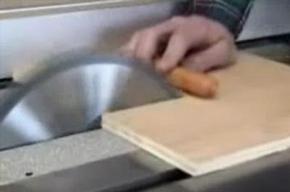WASHINGTON - Table saw owners and operators, as well as others with a vested interest in table saw safety, have a third opportunity to sound off on the U.S. Consumer Product Safety Commission’s controversial table saw safety rulemaking.
 The CPSC extended the public commentary period for a second time since it published an Advanced Notice of Proposed Rulemaking (ANPR) in the Oct.11, 2011 Federal Register. The original deadline for accepting written comments was Dec. 8. The first extension, requested by the Power Tool Institute (PTI), which has voiced strong opposition to CPSC’s table saw rulemaking activities, moved the deadline to Feb. 10. CPSC voted 2-1 to reopen the commentary period for an additional 30 days, also at the request of PTI. The new deadline for submitting public comments is March 16.
The CPSC extended the public commentary period for a second time since it published an Advanced Notice of Proposed Rulemaking (ANPR) in the Oct.11, 2011 Federal Register. The original deadline for accepting written comments was Dec. 8. The first extension, requested by the Power Tool Institute (PTI), which has voiced strong opposition to CPSC’s table saw rulemaking activities, moved the deadline to Feb. 10. CPSC voted 2-1 to reopen the commentary period for an additional 30 days, also at the request of PTI. The new deadline for submitting public comments is March 16.
CPSC Commissioner Robert Adler cast the only vote opposing PTI’s request to reopen the comment period. In a statement posted on the CPSC’s website, Alder, says, “PTI’s request stems from a series of pending Freedom of Information Act (FOIA) requests. As a general proposition, I am in favor of receiving comments from the public, including the regulated community, and I am particularly a supporter of providing as much process as is necessary to achieve the best product we can. However, I do not believe the rationale underlying this request merits an additional delay in a process that I hope will eventually result in the elimination of, or a dramatic reduction in, the risk of amputations and severe lacerations that result from contact with a blade saw.”
Adler has been one of the most vocal proponents of the need for the CPSC to create a mandatory table saw safety. He also has made several public statements suggesting that the flesh detection technology like the SawStop should be required to diminish the chance of saw operator injuries, including lacerations and amputations.
When CPSC issued its ANPR in October, Adler, said, "Shortly after I joined the Commission in 2009, I saw a demonstration of a braking mechanism for table saws, called SawStop, which would stop a saw blade instantaneously upon encountering someone’s finger or hand. This led me to take a look at the injury data for table saws. The injuries associated with this product are horrific – deep lacerations to the arms and hands, broken bones and, worst of all, amputations to fingers and thumbs. Injuries like these often leave victims facing long, painful recoveries as well as significant financial hardship and employment challenges.”
"I am also aware there are other competing technologies to SawStop that have yet to be brought to market,” Adler added. “Although I find myself extremely impressed by the SawStop technology, I am not in favor of writing a standard that would result in mandating a patented technology if such a result is avoidable."
PTI is comprised of 15 portable power tool makers, including Bosch, Delta, DeWalt, Ryobi, and Stanley Black & Decker. The group has campaigned against the CPSC’s plans to create a table saw rule, particularly one that could profiit SawStop LLC and its president Stephen Gass, inventor and holder of numerous patents for the SawStop device. Gass petitioned the CPSC in 2003 to consider promulgating a table saw safety rule saying that voluntary rules and standard saw blade guards were inadequate.
CPSC said it was acting to implement a mandated table saw safety rule based on a study that indicated there are 67,000 table saw-related injuries each year bearing a cost of $2.3 billion.
Written comments about table saw safety will be accepted through March 16 at www.regulations.gov/#!home.
Related Blog
Got an Opinion of Table Saw Safety? Tell the CPSC






Have something to say? Share your thoughts with us in the comments below.